Stirling, Borthwick and Lochleven: The Scottish Haunts of Mary, Queen of Scots
by Tori V. Martínez
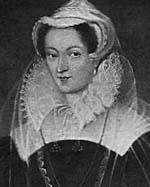 As in
England, where the number of historical establishments that
claim, "Queen Victoria slept here," is legion, the same holds
true in Scotland for Mary, Queen of Scots. In her relatively
brief 45 years of life, Mary seems to have spent at least one
night in just about every castle of note in Scotland. Between
everyday living at her royal residences, numerous Scottish
progressions, various attempts to escape a multitude of threats,
and the early years of her imprisonment, she went from what we
know today as familiar Scottish landmarks like Edinburgh Castle
to near forgotten ruins like Spynie Palace in the Moray region of
eastern Scotland. But if you think the Queen of Scots was busy in
life, wait until you hear all the places she's reportedly
"visited" in the afterlife. There's just something about Mary --
even after all these years -- that makes her an extremely popular
spectral resident of Scottish castles. So much so that it's
possible to track much of her life story just through the claims
of her ghostly presence. As in
England, where the number of historical establishments that
claim, "Queen Victoria slept here," is legion, the same holds
true in Scotland for Mary, Queen of Scots. In her relatively
brief 45 years of life, Mary seems to have spent at least one
night in just about every castle of note in Scotland. Between
everyday living at her royal residences, numerous Scottish
progressions, various attempts to escape a multitude of threats,
and the early years of her imprisonment, she went from what we
know today as familiar Scottish landmarks like Edinburgh Castle
to near forgotten ruins like Spynie Palace in the Moray region of
eastern Scotland. But if you think the Queen of Scots was busy in
life, wait until you hear all the places she's reportedly
"visited" in the afterlife. There's just something about Mary --
even after all these years -- that makes her an extremely popular
spectral resident of Scottish castles. So much so that it's
possible to track much of her life story just through the claims
of her ghostly presence.
A Protected Childhood at Stirling Castle
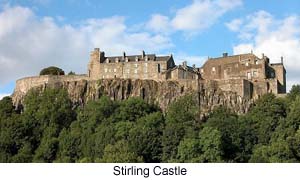 Mary's ghost doesn't give us a completely clean start,
as it's not Mary, but her mother, Mary of Guise, who supposedly
haunts Mary's birthplace, Linlithgow Palace in West Lothian, not
far from Edinburgh. Perhaps the ruined palace just isn't big
enough for the two ghostly queens. In any case, the ghost of the
Queen of Scots -- or, at least of the "Pink Lady" -- is
reportedly present in her second home, monumental Stirling
Castle. According to the stories, the castle is haunted by a
"Pink Lady" and a "Green Lady." It's speculated that the Pink
Lady, who is most fluently described as a "beautiful woman in a
pink silk gown," is either the ghost of the Queen of Scots or
that of a woman doomed for all eternity to search for her
husband, who was killed when King Edward I of England captured
the castle. Mary's ghost doesn't give us a completely clean start,
as it's not Mary, but her mother, Mary of Guise, who supposedly
haunts Mary's birthplace, Linlithgow Palace in West Lothian, not
far from Edinburgh. Perhaps the ruined palace just isn't big
enough for the two ghostly queens. In any case, the ghost of the
Queen of Scots -- or, at least of the "Pink Lady" -- is
reportedly present in her second home, monumental Stirling
Castle. According to the stories, the castle is haunted by a
"Pink Lady" and a "Green Lady." It's speculated that the Pink
Lady, who is most fluently described as a "beautiful woman in a
pink silk gown," is either the ghost of the Queen of Scots or
that of a woman doomed for all eternity to search for her
husband, who was killed when King Edward I of England captured
the castle.
Despite the competitive claim, the case for Mary as the Pink Lady
of Stirling Castle is fairly compelling. Queen of Scotland since
she was six days old, Mary was an extremely vulnerable and easy
target for the kings of England and France, who had their eyes on
the Scottish throne. When she was just six months old, an
alliance between England and Scotland betrothed Mary to England's
Prince Edward, the five-year-old son and heir of King Henry VIII.
The French Mary of Guise vehemently objected to the proposition,
so she took the little queen into hiding at Stirling Castle. It's
unlikely a safer place could have been chosen. The volcanic crag
on which Stirling Castle was built rises some two hundred feet
above the River Forth and provides a commanding view of the
Scottish countryside for miles around. Long appreciated for its
strategic location, a fortress of some sort has existed on the
site since at least the 9th century, although much of the present
castle was built in the 15th and 16th centuries. Mary of Guise
would undoubtedly have known that previous Scottish monarchs had
also sought virtually assured safety at the castle, including her
own husband and Mary's father, James V, who had first been
brought there as a two-year old king by his own mother in
1513.
Once inside the fortress, Mary of Guise arranged for a hurried
coronation ceremony for her daughter, which was held in the
castle's old Chapel Royal on September 9th, 1543. Mary and her
mother lived safely in the castle until 1548, when Mary was sent
to be raised at the French royal Court. She returned to the
castle several times after her return from France in 1561, and it
was there that she sent her son, the future James VI, to be
raised in 1566. Mary's life appeared to come full circle when --
just over 23 years after her coronation -- she attended James'
christening in the same chapel at Stirling Castle. Mary again
visited her son at Stirling Castle on April 24th, 1567, but it
would turn out to be the last time she saw both her son and her
childhood home. Just a few months later, Mary was forced to
abdicate and James was subsequently crowned king.
These are perhaps all good reasons why Mary's spirit might want
to return to Stirling Castle in the afterlife, but her ghostly
appearance would seem to be more closely tied to an incident in
1561 when the curtains of her bed were set on fire by a bedside
candle. Had it not been for a quick-thinking attendant who
rescued the sleeping queen from her burning bed, Mary would never
have had the chance to impact history the way she did.
Unfortunately for visitors to Stirling Castle, the old Chapel
Royal was demolished in the late 16th century, although its more
modern replacement is open to the public, as is most of the rest
of the castle.
A Husband, a Lover and Borthwick Castle
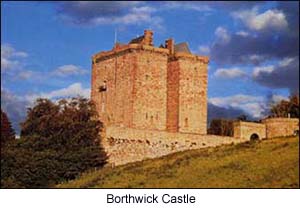 It may seem almost too obvious at this point to say
that Mary didn't have much luck in life. In March of 1566, while
Mary was heavily pregnant, her second husband, Lord Darnley,
brutally murdered her secretary at the Palace of Holyroodhouse in
Edinburgh. Having witnessed the event with her own eyes, Mary no
doubt saw that she needed to rid herself of, and find an
alternative to, her troublesome husband. After the birth of her
son, she evidently filled at least one, if not both, of those
needs with James, Earl of Bothwell. History tells us that Mary
and the earl not only went to work to formulate a plan to get rid
of Darnley, but also began a love affair. It may seem almost too obvious at this point to say
that Mary didn't have much luck in life. In March of 1566, while
Mary was heavily pregnant, her second husband, Lord Darnley,
brutally murdered her secretary at the Palace of Holyroodhouse in
Edinburgh. Having witnessed the event with her own eyes, Mary no
doubt saw that she needed to rid herself of, and find an
alternative to, her troublesome husband. After the birth of her
son, she evidently filled at least one, if not both, of those
needs with James, Earl of Bothwell. History tells us that Mary
and the earl not only went to work to formulate a plan to get rid
of Darnley, but also began a love affair.
In October 1566, Mary learned that the earl had been wounded in a
minor altercation and was convalescing in one of his castles. At
great risk to both her safety and reputation, Mary dropped
everything to be at her lover's side. She and a few select
attendants rode as far as 50 miles to Hermitage Castle on the
Scottish borders, where they stayed for two hours before making
the journey back. On the return trip, Mary caught a chill and the
subsequent fever nearly killed her. It is perhaps this event that
has prompted ghost watchers to claim that the "regal figure" in a
white dress seen on the deserted grounds of now ruined Hermitage
Castle is the ghost of Mary.
Perhaps, but Mary's association with the Earl of Bothwell helped
her leave an even bigger impact on Borthwick Castle, located just
12 miles south of Edinburgh. Now a beautiful hotel, Borthwick
Castle was built in 1430 by the first Lord Borthwick, who was
part of a formidable and ancient Scottish clan well known for its
ferocity on the battlefield. In accordance with the clan's
reputation, Lord Borthwick built an imposing fortress with a
twin-towered keep over 100 feet high, walls 14 feet thick and an
immense great hall. Mary's first visit to Borthwick Castle passed
fairly uneventfully in 1563, as did many subsequent visits, but
her final visit in June 1567 left a lasting impression. Newly
married, she and the earl fled to Borthwick Castle to seek refuge
from and raise forces against a group of very unhappy nobles in
close pursuit. Part of the trouble was that, in February, Lord
Darnley had been killed in a mysterious explosion and Mary and
her unpopular new husband were believed to be at the heart of the
incident.
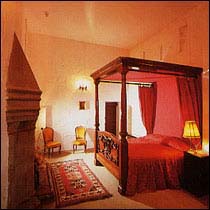 Despite the
castle's impressive credentials as a fortress, it was soon
surrounded by a large armed force and Mary and the earl realized
that their only hope lay in escaping separately. The story goes
that Mary -- who apparently enjoyed dressing up even under normal
conditions -- disguised herself as a page boy to escape
undetected from the castle. Despite their best efforts, both she
and the earl were quickly caught and imprisoned, never to meet
again. Perhaps it's because the newlyweds spent their last days
together there that the unhappy Mary is said to haunt Borthwick
Castle, appearing from time-to-time in a stairwell near The Mary
Queen of Scots Room -- one of several exquisite rooms available
to the castle hotel's guests. Also, in keeping with Mary's
lifetime predilections and escape strategies, she's also been
spotted around the castle dressed as she was when she fled there
-- as a page boy. Despite the
castle's impressive credentials as a fortress, it was soon
surrounded by a large armed force and Mary and the earl realized
that their only hope lay in escaping separately. The story goes
that Mary -- who apparently enjoyed dressing up even under normal
conditions -- disguised herself as a page boy to escape
undetected from the castle. Despite their best efforts, both she
and the earl were quickly caught and imprisoned, never to meet
again. Perhaps it's because the newlyweds spent their last days
together there that the unhappy Mary is said to haunt Borthwick
Castle, appearing from time-to-time in a stairwell near The Mary
Queen of Scots Room -- one of several exquisite rooms available
to the castle hotel's guests. Also, in keeping with Mary's
lifetime predilections and escape strategies, she's also been
spotted around the castle dressed as she was when she fled there
-- as a page boy.
"Polite" Imprisonment at Lochleven Castle
While Mary's spirit lingered at Borthwick Castle, the living
Mary was imprisoned by those unhappy Scottish nobles at Lochleven
Castle near Kinross beginning June 16, 1567. A month later, she
had a double dose of bad luck when she suffered a miscarriage --
twins, who were buried near the castle -- and was forced to
abdicate the Scottish throne in favor of her son. While many of
us would be quite happy to relax in a castle ideally situated on
an island in the middle of one of Scotland's beautiful lochs,
Mary wasted no time in plotting her means of escape. With a keep
that was five stories high and walls about eight feet thick,
Lochleven Castle was nowhere near the caliber of fortress as
Borthwick Castle. On the other hand, Lochleven had at least one
distinct advantage over Borthwick that made escape far more
difficult -- it stood on an island in the middle of Loch Leven.
For Mary, this meant the only way of escaping the well-guarded
castle was by boat.
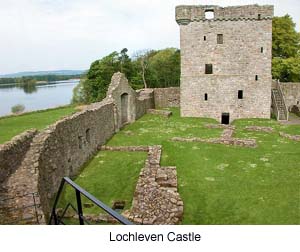 Her first attempt involved making the boat crossing
disguised as the castle's washer woman. Unfortunately for Mary,
the boatman thought it was suspicious that an overworked washer
woman could have such beautiful white hands, and Mary's escape
was foiled. Her second attempt was successful thanks to the
cooperation of her allies, including her jailer's son, who was
apparently smitten with the beautiful young queen. On May 2,
1568, she successfully crossed the loch and made her way to
safety, although, according to various ghost sightings, Mary's
spirit once again lingered behind. Most references to Mary's
ghost at Lochleven Castle are not very specific, but at least one
story suggests that she haunts the castle in search of her lost
twins. Modern day ghost hunters and travelers can still see the
short, round Glassin Tower where Mary was imprisoned, as well as
the keep, which is widely considered to be one the finest
examples of a 14th century keep in Scotland. Like Mary, modern
visitors can only access Lochleven Castle by ferry from a pier in
Kinross, a trip that takes only about 10 minutes today. Her first attempt involved making the boat crossing
disguised as the castle's washer woman. Unfortunately for Mary,
the boatman thought it was suspicious that an overworked washer
woman could have such beautiful white hands, and Mary's escape
was foiled. Her second attempt was successful thanks to the
cooperation of her allies, including her jailer's son, who was
apparently smitten with the beautiful young queen. On May 2,
1568, she successfully crossed the loch and made her way to
safety, although, according to various ghost sightings, Mary's
spirit once again lingered behind. Most references to Mary's
ghost at Lochleven Castle are not very specific, but at least one
story suggests that she haunts the castle in search of her lost
twins. Modern day ghost hunters and travelers can still see the
short, round Glassin Tower where Mary was imprisoned, as well as
the keep, which is widely considered to be one the finest
examples of a 14th century keep in Scotland. Like Mary, modern
visitors can only access Lochleven Castle by ferry from a pier in
Kinross, a trip that takes only about 10 minutes today.
After Mary's earthly escape from Lochleven Castle, she found
refuge at the castle of one of her supporters, James Hamilton,
the 2nd Earl of Arran. The hospitality Mary received at
Craignethan Castle, near the Clyde Valley, must have been a
welcome respite from her period of polite imprisonment, but the
business of reclaiming her crown awaited her and her stay was
accordingly short. Unfortunately for Mary, her hopes of achieving
victory in Scotland were dashed on May 13th, 1568 at the Battle
of Langside, which led to her escape to England and her eventual
execution. Unlike her other hauntings, Mary's spirit seems to
have returned to Craignethan Castle not as she was when she left,
but as she was after her execution -- that is to say,
headless. Of course, since it's difficult to identify a headless
ghost, it is only assumed that the "headless lady dressed in
white" spotted in the castle's old tower is, in fact, the spirit
of Mary, Queen of Scots.
The story of Mary's mortal presence in Scotland ended with her
escape to England, where she threw herself on the mercy of her
cousin, Queen Elizabeth I of England. Justifiably suspicious of
the woman who was one of the strongest rival claimants to her
throne, Elizabeth promptly imprisoned Mary, moving her from one
English castle to another for the next eighteen years. As she had
in Scotland, Mary made an equally significant impact on the
English castles where she was imprisoned, both in her own
lifetime and in the afterlife. But that is another story.
More Information:
We regret that we no longer have the resources to maintain up-to-date links and/or hours and pricing details for the various sites and attractions listed on this website. For more information about the location(s) listed above, please use your favorite search engine or visit Wikipedia.
Tori V. Martínez is a writer and freelance public relations professional who spends as much time as possible researching and writing on her favorite subject -- history. Several years ago, Tori eschewed the life of a full-time career woman to travel and live around the world, particularly in Britain, where she spent considerable time exploring and researching historic destinations. At the moment, she is living in the US with her husband -- a Spaniard she met in England -- and is happily writing for a variety of online and print publications.
Article © 2006 Tori V. Martínez
Photos of Stirling Castle and Lochleven Castle courtesy of Undiscovered Scotland (http://www.undiscoveredscotland.co.uk); photos of Borthwick Castle courtesy of Celtic Castles (http://www.celticcastles.com).
|
